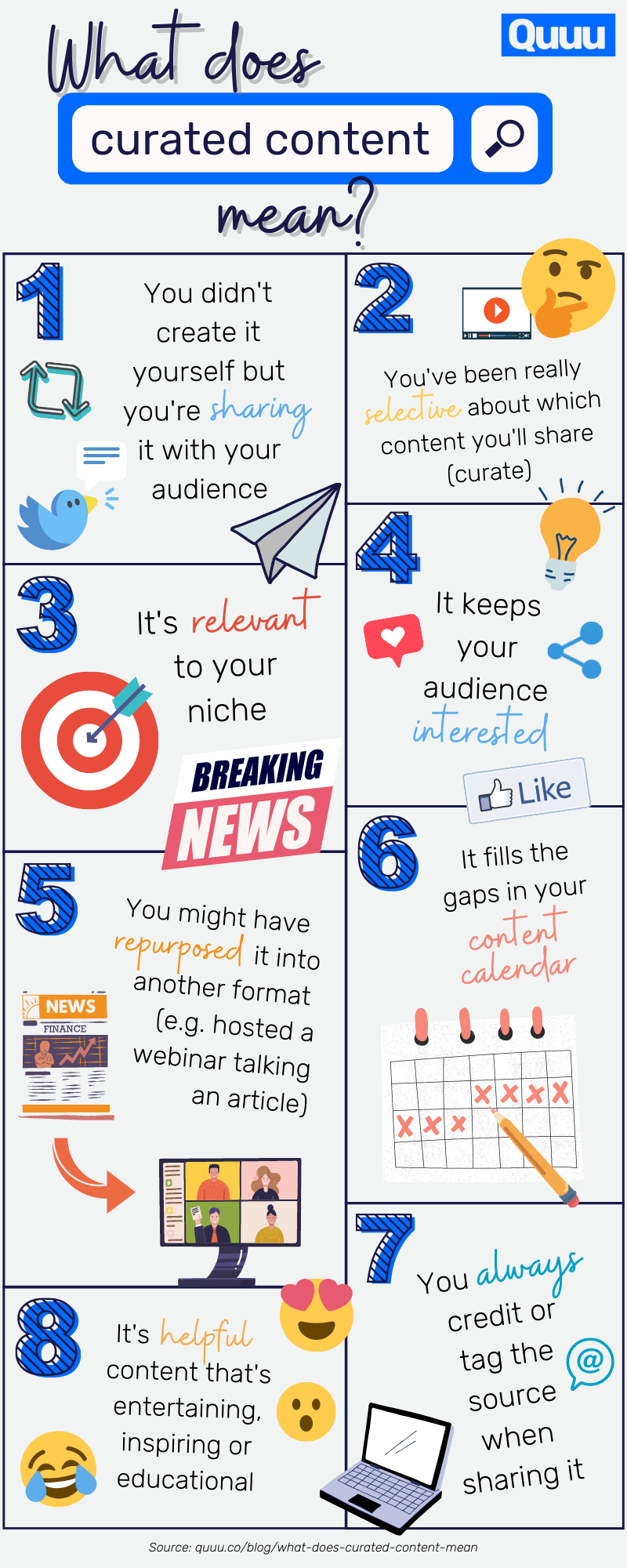“What does curated content mean? Heck, what’s curation?!” These aren’t dumb questions. Especially if you’re new to content marketing.
Original content is everything you create yourself. Curated content is made by others. Usually in (or related to) your industry. You find it. Then share it. It’s a form of marketing, but it isn’t about you or your business.
There are tons of benefits of content curation. It stops you looking too self-promotional. It keeps your social media feeds full of interesting content your audience will love. But this isn’t about “why”. This is covering “what”.
The 8 main elements of curated content are:
- It’s not your own original content
- You’ve been really selective
- It’s relevant to your niche
- It keeps your audience interested
- It may have been repurposed
- It fills gaps in your content calendar
- You always credit or tag the source
- It’s entertaining, educational, or inspiring

1. It’s not your own original content
As mentioned, curated content isn’t made by you. But you are choosing to share it. For example, retweeting is curation in its simplest form. But why would you want to share content you didn’t create? Especially if you’re trying to market yourself?
Well, you know that person that always talks about themselves? You don’t want to be that person. People don’t like to be constantly sold to. Even user-generated content can feel too promotional if used too much.
That’s why curating should be a big part of your marketing strategy. Sharing other people’s content shows you don’t just want to plug yourself or your own business all the time. Your content strategy is about providing value.
In saying that, you can use curated content to form semi-original content of your own. Like a curated blog post you’ve put together about different articles you’ve found on a certain subject. We’re getting to that…
2. Content curation means being really selective
You might be familiar with a curator at an art gallery. Their job is to find specific types of pieces that fit the exhibition they’re planning. They have to spend time researching and sourcing the best art they’re sure visitors will be interested in.

Source: GIPHY
Curated content has exactly the same goal. Your job is to curate (find) and share the best content for your target audience. And there are tools that can help you with this (more on those later!)
But to really master this part, it means putting in the time to find unique stuff. Not a piece of content that’s been shared hundreds of times already. Choose a specific topic. Be picky. And find something awesome.
3. Curated content is relevant to your niche
While there is a ton of cool content out there, you must stick to your niche. There may have just been a shocking influencer breakup, but is it something an architect’s audience would care about? Chances are, probably not.
Content relevance is one of the most important elements of SEO (search engine optimization). So, think of your curated Tweets, LinkedIn posts, and other social content in the same way. Anything you post has to be relevant content for your audience.

But this doesn’t mean you can’t think outside the box a bit.
If you’re an accountant, find an awesome guide to starting a new business. A car dealership could share a video about how to change a tire. Or a surf shop could curate a yoga series that’ll improve surfing posture. You’re only limited by your creativity.
4. Curating keeps your audience interested
Social channels are full of content battling the algorithms. And it just keeps on coming. If you’re not creating enough content to keep up, you can quickly be forgotten. Curated content keeps things flowing, so you stay top of your audience’s mind.
You might be an expert or thought leader in your field. But you can’t know everything. Curating also ensures your social media content is from a mix of minds. Rand Fishkin has this strategy nailed:
Other people have different skills than you too. You might not have the time or budget for a high-quality short film, but others do! Keep your audience interested with a bunch of new content. From a mix of people. With far less effort.
5. You may have repurposed curated content
We all know how long content creation takes. But with curated content, other content creators have done the hard work for you!
Now, that doesn’t mean you have to share it exactly like you found it. Why not turn it into something more interesting? Repurposing transforms one type of content into another.
For example:
- An article into a webinar
- Talking points from a podcast into an infographic
- An eBook into a blog post list of statistics
- Statistics into separate social media posts
- Blog posts into curated email newsletters

Repurposing could end up being one of your most powerful forms of digital marketing. If you’d like to give it a go and try creating your own curated infographics, try tools like Canva which have tons of templates.
Just don’t forget #7 in this list if you do choose to repurpose anything!
6. Curation fills gaps in your content calendar
Creating your own content is hard work. And it can take a long time to produce great content. But people’s attention can be fickle. Especially on social networks.
Social media marketing requires you to post consistently. Or risk losing the attention of your audience. This is where a curation strategy comes in. Because you can have a steady stream of quality content always ready to be shared.

Source: GIPHY
If you’re struggling to make enough content to post daily, go find some. This’ll be especially helpful if you don’t have an in-house marketing team. Curation means you’ll always have a full content calendar. No extra team members necessary.
7. You always credit or tag the source on social media
This is the golden rule of curated content. And for obvious reasons. Imagine you’d worked hard on a post for your social media strategy. Then imagine someone shared it with their audience and claimed it as their own!
That wouldn’t be fun. So, be careful not to do it to other people. Even unintentionally.
If you’re curating like a pro, you’ll be adding unique value to everything you post on social media. But don’t forget attribution to the source too.
This blog post is a great example of making the source clear:

Source: HubSpot
Tag them on Twitter. Reference them in the blog post. Shout them out in the video. Link to the original. Whatever kind of online marketing you’re doing – credit the creator!
8. Curated content is entertaining, educational, or inspiring
Anyone can find content to curate. You can type some keywords into a search engine. Or scroll through social media platforms. Either way. You’re good to go.
But your curated content should be high-value and helpful. You shouldn’t just be retweeting anything you see willy-nilly. Where’s the value in that?
Curated content that you select should be:
- Entertaining
- Educational
- Inspiring
- Or all of these things!
Do some digging and find content creators that are doing something different. Like this cryptocurrency YouTube channel:
The idea is to turn your site or social profiles into an expert resource of content from all over the web. Your audience knows that anything you post is going to evoke some kind of emotion. That’s the main goal.
Content curation tools can help you master curating
Finally, something to help. There are tons of content curation tools out there that can make it easy. Most are aggregation apps – which basically means they gather up content for you to choose from.
Some are for social media posts. Some are for creating newsletters. Some are simply for discovering content through RSS feeds.

Source: Quuu
Whatever you need, here are 7 content curation tools we love:
- Quuu – social media content curation and scheduling
- Pocket – a simple read-later tool
- Scoop.it – create web pages with curated content
- BuzzSumo – find trending content
- Triberr – access closed-door content
- Flipboard – free smart news app
- eLink – newsletter creator for curated content
These can help with all stages of the curation process. Whichever type of curated content you choose to make, let technology give you a hand.
Conclusion
Hopefully, you should now understand what curated content means. And how you can become a pro at using it.
In a nutshell, it’s content created by others that you choose to share with your audience. It’s high-quality and relevant to your niche. And you always credit the source of it.
It’s a simple concept, though easy to get wrong. But if you stick to the 8 elements above, you’ll be fine. Scratch that – you’ll be great!
Do you curate content already? What accounts do you think your audience would love? Let us know in the comments!





